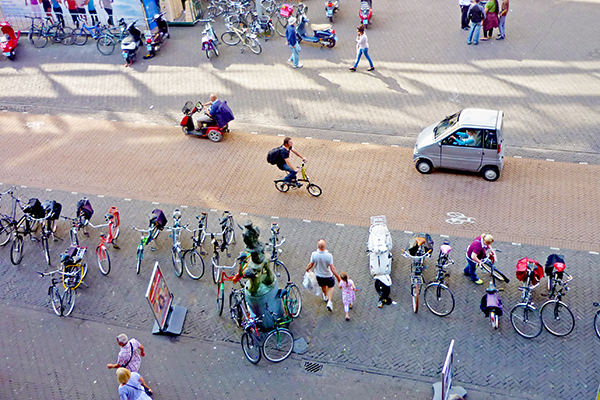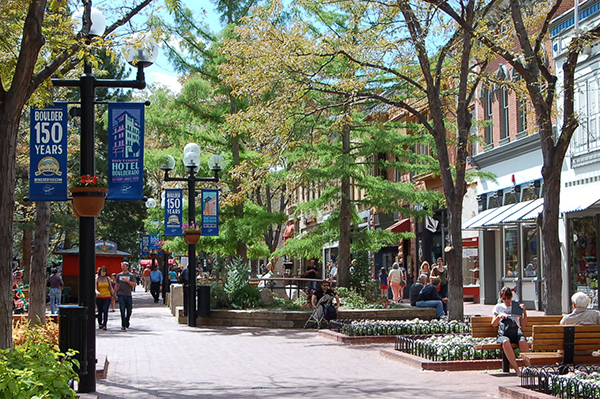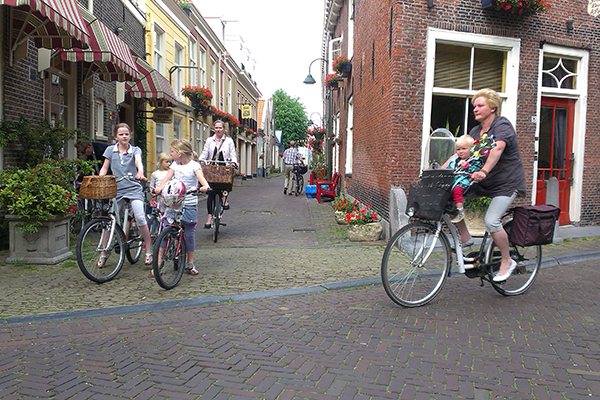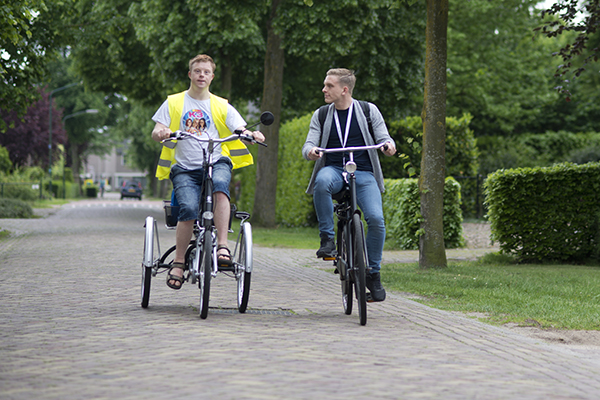Accessibility / Equity / Innovation / Mobility / Public Spaces / Shared space
Sharing Space: Not just for the Dutch
In the Netherlands, only 20% of their street network features dedicated bicycle facilities, yet they boast some of the world’s highest levels of cycling and walking. How do the Dutch pull that off? The answer is perhaps not as complex as you may think. Nearly all of the remaining 80% of their streets have speeds lower than 20 mph–speeds low enough to allow for mixed traffic, creating a shared street.

Shared streets have been playing a very prominent role in Dutch mobility networks for decades. However, this solution is not specific to the Netherlands. In recent years we have seen a slow return of shared spaces to the American landscape, with an increase in interest in this design model as people see how they can work in the States. New proposed plans place more emphasis on low-stress networks as well as downtown cycle and pedestrian facilities.
Still, many of these projects tend to default to protected and/or separated infrastructure, when an equally effective solution that would be to also create quieter, calmer streets. A network where all road users move slowly through the traffic calmed, shared space. In order to expand the application of shared streets, an increased understanding of how that are implemented needs to happen.
A design for equity and accessibility
This trend towards shared streets is indicative of not just a new type of infrastructure, but a new focus on people-centric cities and their needs. Designers are focusing on the types of people using the space, the purpose of their trip, and how they would like to use the space, rather than just focusing on the vehicle. This in turn changes the conversation from the mode of travel to one about increasing accessibility.
We are asked a lot about equity in the Dutch approach–something we’ve developed a lot of language for in the States, but not as much in the Netherlands. That being said, the Dutch approach to network and street design is inherently equitable in its execution. Shared spaces being the most obvious example of this. The design of the infrastructure itself demands near equity amongst vehicle types. Flat surfaces, similar material use from door to door – it simply looks equitable and inclusive.
In addition to creating more pleasant spaces for people, the shared street model is also an affordable way to achieve many of the goals of Vision Zero. We already know slow speeds decrease the rate of fatality and serious injury for people walking and cycling. But we also know that lower income families are more likely to walk, bike, or bus (incl. walking to/from the bus) and are subsequently more likely to a victim of a car crash in less safe conditions. Slow shared streets create equity through increased safety–the space is more accessible to a variety of modes in a traffic calmed environment and is therefore safer for the most vulnerable road users.

Shared space and new mobilities
The concept of a shared space is often understood in terms of a pedestrian mall, like Pearl Street in Boulder. But one of the earliest examples we can find throughout the US is the neighborhood bicycle boulevards which are becoming more and more common. What’s emerging perhaps more quickly is new modes of mobility and how they behave in our built environment.
I think shared streets have the potential to offer a meaningful solution to all of these new modes/approaches to mobility. Each year more people are moving to downtown areas and more types of mobility options (shared bikes, car share, e-scooters, etc.) are being introduced. Infrastructure is expensive. We can’t continue to build out and create separate space for all these different modes.
In our study for ANWB, Mobycon explores the theme of urban zones and how to cater shared spaces to various vehicle families/user types. A design prescription for a pedestrian-oriented shared space, one for a shared space designed around the bike family (bicycles, skateboards, rollerblades) and another for light motor vehicle family (e-bikes, Neighborhood Electric Vehicles, etc.). As we expand our design palette, we become better prepared to match the design of our street to the design of the buildings along it, and thereby the people using it.

“Complete for whom?”
There is also another trend helping the evolution of complete streets into the shared space conversation is by asking, “Complete for whom?” One of my favorite examples of this is a picture of a woonerf (living street) which a Dutch colleague explained was a complete street, despite it not matching the typical image that comes to mind when talking about complete streets in North America. The woonerf is complete for the people who use it–babies in strollers, kids on bikes, parents picnicking.
A big part of implementing shared space is re-evaluating the responsibility of the network in managing traffic. So Main Street doesn’t have to be a truck route, but rather can become a pleasant, slow street, accessible to those who want to stay and shop, people watch, etc. We are excited by the understanding of and demand for shared streets catching on in more places. It is opening the discussion up to all types of shared streets–from home zones and living streets to pedestrian malls to bicycle streets. Combined under the shared space model they can be used as excellent tools for a safe, connected and people-centered downtown.
Join Mary at APBP for a mobile tour of Portland’s shared spaces on Tuesday, 27 August. More details here: https://mobycon.com/updates/talking-safe-systems-in-portland/
If you’d like to learn more about the history of shared space, see this post written by Dick van Veen and our colleagues at PPS: https://www.pps.org/article/what-is-shared-space


